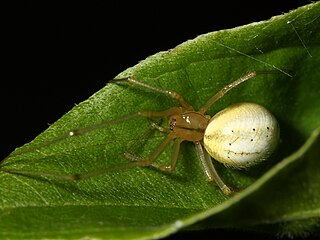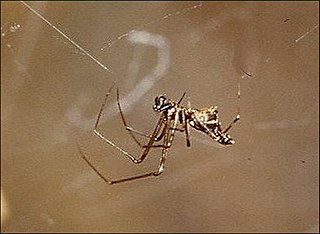
Theridiidae, also known as the tangle-web spiders, cobweb spiders and comb-footed spiders, is a large family of araneomorph spiders first described by Carl Jakob Sundevall in 1833. This diverse, globally distributed family includes over 3,000 species in 124 genera, and is the most common arthropod found in human dwellings throughout the world.

Scaffold web spiders or cave cobweb spiders (Nesticidae) are a family of araneomorph spiders closely allied with tangle-web spiders (Theridiidae). Like the Theridiidae, these spiders have a comb of serrated bristles on the hind tarsi that are used to pull silk bands from the spinnerets. Nesticidae contains 16 genera and about 300 species, many of which are associated with caves or overhangs. The genus Nesticus is the type for the family and is found throughout the world. The related Eidmannella has speciated considerably in Texas caves and includes some extremely localized species that are considered threatened. One species, Eidmannella pallida, is found in caves and under overhangs, but also in agricultural fields and other habitats away from such restricted areas. The genus Carpathonesticus is found in central Eurasia.

Argyrodes, also called dewdrop spiders, is a genus of comb-footed spiders that was first described by Eugène Louis Simon in 1864. They occur worldwide, and are best known for their kleptoparasitism. They can spin their own webs, but tend to invade and reside in their hosts' webs. This relationship can be commensal or even mutual if the dewdrop spider feeds on small trapped insects that are not eaten by the host. Some species can even prey upon the host.

The Seychelles paradise flycatcher is a rare bird from the genus of paradise flycatchers (Terpsiphone) within the family Monarchidae. It is a forest-dwelling bird endemic to the Seychelles where it is native to the island of La Digue. Males have glossy black plumage with elongated tail feathers, while females are reddish-brown with pale underparts and no long tail feathers. The International Union for Conservation of Nature lists this bird as being "Vulnerable" and attempts have been made to increase its numbers by relocating some individuals to Denis Island, another island in the Seychelles archipelago.

Geoffroy's bat, also known as the notch-eared bat, is a species of vesper bat.
Andasta is a genus of ray spiders that was first described by Eugène Louis Simon in 1895.
Andasta siltte is a species of ray spider that is endemic to the Seychelles. It is only known from a single specimen from Silhouette Island. It is found in woodlands at the lower edge of cloud forest. It is threatened by habitat deterioration, from invasive plants and climate change.

Argyrodes cognatus is a species of tangle-web spider that is endemic to the Seychelles, and can be found on Mahé, Conception, Silhouette and Marianne islands. It is found in woodland habitats where it spins orb webs in herbaceous vegetation. It is threatened by habitat deterioration due to invasive plants, especially Cinnamomum verum.
Argyrodes fissifrontellus is a species of tangle-web spider that is endemic to the Seychelles, and can be found on Mahé and Silhouette islands. It is found in woodland areas where it spins orb webs in vegetation, or is a keptoparasite in red-legged golden orb-web spider webs. It is threatened by habitat deterioration due to invasive plants, especially Cinnamomum verum.
Argyrodes rostratus is a species of tangle-web spider that is endemic to the Seychelles, and can be found on Mahé, Île Sèche, Cerf, Conception, Silhouette, Curieuse, Cousin, Aride, Praslin, La Digue, Grand Sœur, Felicite, Marianne, Denis islands and the Alphonse and St. François atolls. It is found in woodland, shrubby habitat and gardens, and is a kleptoparasite of red-legged golden orb-web spiders. It is threatened by habitat deterioration due to invasive plants, especially Cinnamomum verum.
Zoma zoma is a species of ray spider that is endemic to Silhouette Island of Seychelles. It was first described by Michael I. Saaristo & A. V. Tanasevitch in 1996. To date Zoma only contains its type species Zoma Zoma. The name of Zoma refers to the belt of silvery corpuscles on the abdomen of the type species. Not much is known about males of the species. Females have a total length, not including chelicerae, of 1.79 mm. It is threatened by habitat degradation from invasive plants, such as Cinnamomum verum.
Pleorotus was a monotypic genus of Seychelloise huntsman spiders containing the single species, Pleorotus braueri. It was first described by Eugène Louis Simon in 1898, and was endemic to the Seychelles. The description was based on a single male collected on Mahe Island in 1894, but none have been found in later collections, and it has been declared extinct.
Nanume is a monotypic genus of comb-footed spiders containing the single species, Nanume naneum. It was first described by Michael I. Saaristo in 2006, and is found on the Aldabra Atoll.
Sesato is a monotypic genus of African comb-footed spiders containing the single species, Sesato setosa. It was first described by Michael I. Saaristo in 2006, and is found on the Seychelles.

Seycellesa is a genus of spiders in the family Theridiidae. It consists of only its type species: Seycellesa braueri, which is endangered and endemic to the Seychelles.
Spinembolia is a monotypic genus of African comb-footed spiders containing the single species, Spinembolia clabnum. It was first described by Michael I. Saaristo in 2006, and is found on the Seychelles.
Stoda is a monotypic genus of African comb-footed spiders containing the single species, Stoda libudum. It was first described by Michael I. Saaristo in 2006, and is found on the Seychelles.
Euso muehlenbergi is a species of spiders in the family Ochyroceratidae. It was first described in 1998 by Michael Saaristo. As of 2021, it is the only species in the genus Euso, erected by Michael Saaristo in 2001. It is found in the Seychelles.
Roche roche is a species of spiders in the family Ochyroceratidae. It was first described in 1998 by Michael Saaristo. As of 2021, it is the only species in the genus Roche. It is found in the Seychelles.
Bardala labarda is the only species in the monotypic genus Bardala, a member of the comb-footed spider family Theridiidae. It was first described by Michael I. Saaristo in 2006, and is endemic to the coral atoll of Aldabra.







